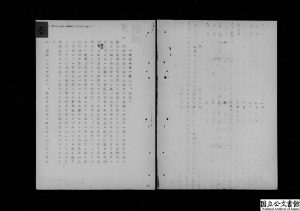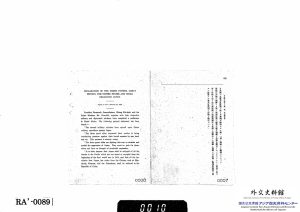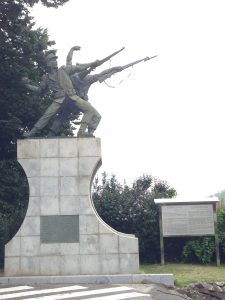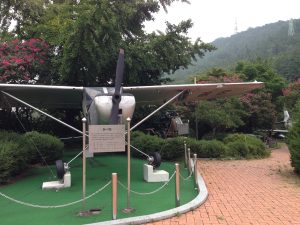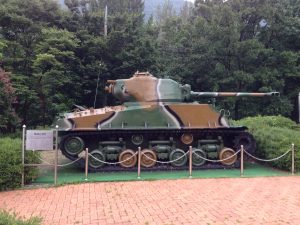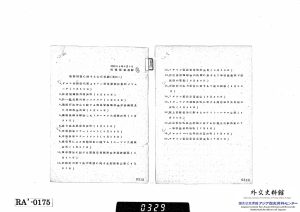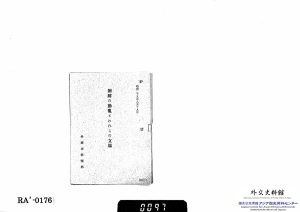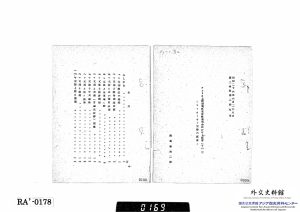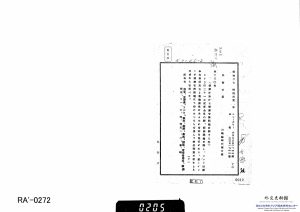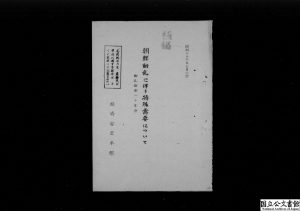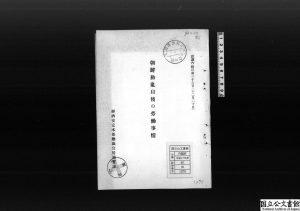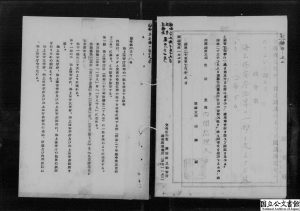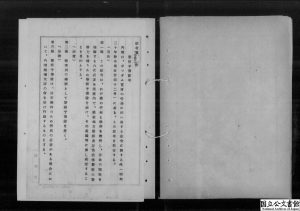JACAR Newsletter
JACAR Newsletter Number 42
December 27, 2023
Documents Spotlight (2)
The Korean War and Japan
The year 2023 marks the 70th anniversary of the ceasefire ending hostilities in the Korean War. The Korean War broke out in June 1950, and three years and one month were used up before an armistice agreement was signed at Panmunjom in July 1952. With the United Nations Command—a military force with U.S. armed forces at its core—taking part in the conflict from the outset, and the Soviet Union and the People’s Republic of China (PRC) also involved, we will use materials from JACAR to have a look back at this conflict that has been described as one that turned the Cold War hot.
Among the records available through JACAR is a series of documents supplied by the Ministry of Foreign Affairs’ Diplomatic Archives titled, “Chōsen dōran kankei ikken” [Matters related to the Korean upheaval]. The documents in this series have been organized into six themes: (1) the war’s progress; (2) the stances of various countries and the tone of public opinion and newspaper coverage in each; (3) the tone of public opinion and newspaper coverage in the United States, including the issue of General MacArthur’s dismissal from his duties; (4) matters related to the progress of ceasefire talks; (5) matters related to Korean reconstruction; and (6) deliberations within and the stance of the United Nations. Also, one of the unique features of this collection that we can bring up is that it is focused on information from the United Nations and particularly from the US, reminding us that Japan was occupied by the Allied Powers when the war broke out. Furthermore, the war years were a delicate time that extended across the signing of the San Francisco Peace Treaty. The fact that such issues as the restoration of Japan’s independence and its joining the Western bloc can also be observed in some form also makes this a unique collection of records.
1.History Prior to the Korean War: Liberation from Japan and the Birth of a Divided State
Let us now try to trace the progress of the Korean War from JACAR materials. We’ll do so by first looking at the course of events by which the Korean Peninsula was divided up at the 38th Parallel, i.e. latitude 38° N.
With the end of World War II, Supreme Commander for the Allied Powers(SCAP)’s General Order No. 1 instructed Japanese forces in Korea north of the 38th Parallel to surrender to the army of the Soviet Union, while those to the south were to surrender to US forces. This marks the origins of the military border that remains to the present day.
This dividing line would subsequently become intertwined with the issue of Korean independence, and it would be drawn across both firmly and heavily. The US, the United Kingdom, and the Republic of China (ROC) had already issued a joint statement (the Cairo Declaration) on December 1, 1943, that brought up the matter, saying “in due course Korea shall become free and independent” (Image 2), with “in due course” having connotations of “after going through a trusteeship.”
Next, to handle matters after the war, it was decided at a meeting of the US, UK, and Soviet foreign ministers held starting December 16, 1945, that a provisional Korean government was to be established. The preparations for that government were to be undertaken by a joint commission comprising representatives from the US and Soviet commands in Korea, and until Korea was completely independent it would be placed under a four-power trusteeship comprising the US, the Soviet Union, the UK, and the ROC (“Moscow Agreement,” i.e., the Moscow Conference). The concept of a trusteeship created a split between pro- and anti-trusteeship factions among the Korean people. Meanwhile, the joint US-Soviet commission bogged down, and would be adjourned indefinitely in May 1946.
With the joint commission having come to a halt, in September 1947 the US brought the issue to the UN General Assembly. The Soviet Union criticized the move as ignoring the Moscow Agreement, but the US proposal to change the initial trusteeship proposal was passed. The UN recommended that elections be held in both the northern and southern zones by March 31, 1948, and decided that the voting would be supervised by the UN. However, the Temporary Commission on Korea (UNTCOK) dispatched by the UN was not allowed to enter the northern zone, and so, on February 26, 1948, with the countries of the Soviet bloc abstaining, a proposal to hold a separate vote only in the southern zone was adopted.
The separate vote proposal immediately drew opposition from people in the southern zone. Some 300,000 workers opposed to the separate election called a general strike, and there was a fierce uprising on Jeju Island. Jeju Island from the first had been the home to a strong leftist presence, and so the US military government thoroughly suppressed this popular uprising (the Jeju April 3 incident). There was also a meeting of northern and southern political leaders who resolved to establish a unified government and see the withdrawal of all occupying armed forces (the North-South Conference). However, these movements to oppose a separate election were clamped down on by the US military government. On August 15, 1948, the independence of the Republic of Korea (under President Rhee Syngman) was declared, followed on September 9 by a declaration of the establishment of the Democratic People’s Republic of Korea (under Premier Kim Il Sung).
In this way, a state divided into northern and southern zones was created. Rhee pressed for “Unification through Northward Advance,” while Kim’s goal was “Liberation of the South,” and so routes to anything other than unification by force were gradually being closed.
2. The Outbreak of Korean War, and Events Through Ceasefire
The Korean War broke out just before dawn on June 25, 1950. The Korean People’s Army (KPA) crossed the 38th Parallel and began moving south. Around that time, there had been ongoing small clashes along the 38th Parallel, and the South Korean side seems to have believed this was another such occasion. However, the North Korean side was fortified with Soviet-made arms and equipment. Two days later, Seoul fell, and within two months of the war’s outbreak nearly all of parts of the Korean Peninsula excepting in the vicinities of Daegu and Busan had been brought under the control of the KPA.
At the same time, the US involved itself deeply from the outbreak of the war. Soon after fighting broke out, the US requested that the UN Security Council be convened and—with the Soviet Union boycotting its sessions—that body declared North Korea’s actions to be “a breach of peace” and an act of aggression. On June 27, the Security Council recommended that UN members furnish military assistance to South Korea, while President Harry S. Truman in the US issued orders dispatching the US Navy to Korea. Furthermore, on June 30 Truman also ordered the US Army to send troops to Korea, and with this the US was fully involved in the war. On July 7, the Security Council passed a resolution that led to the formation of a unified command for UN forces (United Nations Command), and asked the US to designate a commander, leading to General MacArthur’s appointment to that position.
North Korea’s upper hand was reversed on September 15 when US forces landed at Incheon. Within two weeks of the landing, the US forces had recaptured almost the whole of South Korea, including Seoul. This had largely restored conditions to their prewar state, but the UN Command aimed to drive further north. The UN resolution of June 27 originally called for North Korea to withdraw their forces to the north, and the objective of the US from the outset was also to repulse the KPA. However, ROKA forces under General MacArthur’s command crossed the 38th Parallel on October 1, followed on October 7 by other UN forces, and with this the war expanded. Pyongyang fell, troops landed at Wonsan, and the UN forces gradually drew closer to the border with China. Meanwhile, a Chinese “People’s Volunteer Army” (PVA) had crossed the Yalu River and entered North Korea. On November 24, fierce fighting broke out. Now, the UN forces were forced into their “strategic withdrawal” of December due to the PVA’s counterattack. In the aftermath, a struggle continued between MacArthur, who was planning an all-out response to the act, and the US government, which wanted to call for ceasefire negotiations. Finally, on April 11, 1951, President Truman announced that MacArthur—Commander of the US Far East Command, Supreme Commander for the Allied Powers, and Commander of the United Nations Command—was relieved of his posts, and on April 16 MacArthur departed from Japan.
One year after the outbreak of hostilities, conditions were at a stalemate. On June 23, 1951, the Soviet Union’s delegate to the UN Yakov Malik proposed an armistice, and the first peace talks took place at Kaesŏng on July 10. The ceasefire talks were faced with heavy going due to such issues as where to draw the border between North and South, and how to handle the repatriation of prisoners of war (POWs). However, a new phase opened in December 1952 with a proposal the Indian government made to the International Committee of the Red Cross on the exchange of wounded POWs. The exchange of sick and wounded POWs led to a resumption of armistice talks. On July 27, 1953, UN Command representative and US Army Lt. General William Harrison Jr. and KPA General Nam Il signed the armistice agreement, with UN Command’s commander General Mark Clark, KPA Supreme Commander Kim Il Sung, and People’s Volunteer Army Commander Peng Dehuai also signing the documents. The South Korea representative did not sign due to President Rhee’s opposition. Rhee held out for his “Unification through Northward Advance” policy as the armistice talks progressed, and for that reason opposed the agreement.
By the time armistice talks began, the Chinese and North Korean forces had crossed the 38th Parallel twice, and the UN Command forces three times. So much fighting had taken place around the area bounded Cheorwon, Pyonggang, and Kimhwa near the border that it came to be referred to as “the Iron Triangle.” With the lines of battle having moved back and forth to north and south, the Korean Peninsula was left in ruin, and it is not hard to imagine that the road for the reconstruction to come would be an arduous one.
3. The Korean War and Japan
In what ways, then, was Japan connected with this war? Let us look once again at some of the materials in the JACAR collection that illustrate its involvements with the conflict.
As is well known to students of modern Japanese history, Japan experienced the so-called “special procurements” spike in the form of a spike in demand owing to the war. At the time, Japan was groping toward building a self-supporting economy, and the massive amount of orders placed by the US military came to be thought of as the medicine for recovery. An Economic Stabilization Board (Keizai Antei Honbu) report from July 31, 1950 titled “Chōsen dōran ni tomonau tokushu juyō ni tsuite” [Regarding special procurements consequent on the Korean upheaval] estimated special procurements for the one month after the outbreak of hostilities as totaling ¥6.4 billion [approx. US$17.8 million at the fixed 1950 exchange rate of ¥360 = US$1]. Reports on special procurements were issued continually. As of July 1951, the contracted amount of special procurements had reached ¥113.5 billion. A breakdown shows that the three categories of textiles and fabrics, machinery, and metals and metal products accounted for nearly three-quarters of the total. In the area of services, large amounts came from automobile and machinery repairs along with rail transport.
However, this prosperity appears to have been a little different when it comes to general situation for labor. According to another Economic Stabilization Board report titled “Chōsen dōran igo no rōdō jijō” [Labor conditions since the Korean upheaval], “From the aspect of labor, generally speaking rapid fluctuations were largely not observed.” The special procurements were localized and particular, and hence their impact was only partial, it observed. The increased volume of work was addressed through such means as more overtime for current workers, an increased reliance on subcontracting, and reassigning workers. Only when such approaches were not possible was there an increase in staffing, and that was handled through temporary hires.
The Korean War also had a major impact in non-economic areas. On July 8, 1950, General MacArthur sent a letter to the prime minister on augmenting Japan’s police forces to make up for the “national security vacuum” created by having dispatched US forces based in Japan to Korea. It called for reinforcements for the Maritime Safety Agency (MSA) and the establishment of a National Police Reserve.
On October 23, the government issued an ordinance that revised a section of the Maritime Safety Agency Law, easing restrictions on the numbers of MSA personnel and ships. The revisions increased the number of personnel from 10,000 to 18,000, the number of ships from 125 to 200, and the total displacement tonnage of those ships from 50,000 tons to 80,000 tons (see Image 12).
At the same time, on October 2, 1950, in response to a request from SCAP, it was decided that MSA minesweepers would carry out minesweeping operations in Korean waters. North Korea had laid numerous Soviet-made mines in order to hinder UN forces from performing landings, and the UN forces needed them to be cleared for their landing at Wonsan. It was minesweepers from a still-Occupied Japan that were pulled together for the task. According to Ōkubo Takeo, who was head of the MSA at the time, the minesweeper squadron—known as the Japanese Special Minesweeping Force—comprised 20 minesweepers, four patrol boats, and one experimental vessel. Under orders from the commander of the US Navy’s minesweeper force, the squadron set sail at 6 p.m. on October 6. Ōkubo relates that a majority of the sailors were experts who had served on minesweepers in the Imperial Japanese Navy. The ships worked for around two months to clear the waters around Wonsan, Incheon, Gunsan, Jinnamp’o (Nanpo), and Haeju before the squadron was disbanded on December 15.
Additionally, the National Police Reserve Law promulgated on August 10 (see Image 13) led to that force’s creation, with the first enlistment taking place on August 23. The Reserve was reorganized in October 1952 into the National Security Force, before becoming the Self-Defense Forces in July 1954.
The agreement concluded 70 years ago at Panmunjom was an “armistice,” but even today the situation between North and South is nothing more than a ceasefire. Even now, bringing this war to an end remains a task that will face tremendous difficulties. It brings us a renewed sense of just how difficult it is to end a war once it has started.
Literature Cited
Kamiya Fuji. Chōsen sensō: Bei-Chū tairitsu no genkei. Chūkō Shinsho, 1966.
Cummings, Bruce. Chōsen sensō no kigen, dai-1-kan, trans. Chung Kyung-Mo, et al. [trans. of The Origins of the Korean War, vol. 1; Princeton, NJ: Princeton University Press, 1981). Shiarehimu-sha, 1989.
Chōsenshi Kenkyūkai, ed. Chōsen no rekishi, shinpan. Sanseidō, 1995.
Rhee Kyung Min. Chōsen gendaishi no kiro. Heibonsha, 1996.
Kim Dong Choon. Chōsen sensō no shakaishi: Hinan, senryō, gyakusatsu. Heibonsha, 2008.
Ōkubo Takeo. Uminari no hibi: Kakusareta sengoshi no dansō. Kaiyō Mondai Kenkyūkai, 1978.
Maritime Safety Agency, Administration Department, Policy and Legal Affairs Division, ed. Kaijōhoanchō 30-nen shi. Kaijōhoan kyōkai, 1979.
SAITO Ryoko, Assistant Researcher, Japan Center for Asian Historical Records

